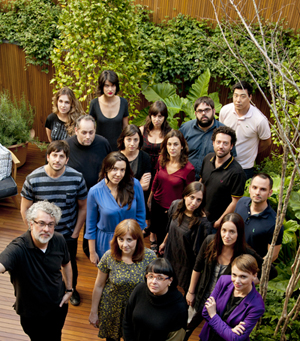The horizontal roof is landscaped with a grass blanket equal to that of the urbanization in which it is raised dedicated to golf. "The house becomes a continuation of the surrounding topography" says Marcio Kogan.
The roof works as a large horizontal plane that extends far beyond the perimeter walls of the house, generating an open space that covers the living and dining areas in the open air in the southern area and passing over the parking area on the side north. The interior organization is articulated longitudinally by a central corridor. To the east, looking at the curved brick wall, Kogan placed the kitchen, the staff bedrooms and a gymnasium. On the other side, opening to the landscape, are the bedrooms and bathrooms of the family, with views to the west.
Descripción del proyecto por Studio mk27
Planar House is a radical exercise in horizontality, aspect commonly explored in the projects of the studio. Discreetly inserted in the highest point of the plot and favoring the existing topography, its presence is most strongly felt in the footprint rather than volumetrically. An extensive line in an open landscape.
This type of insertion on the plot demanded care and attention with the design of the rooftop, which is the fifth facade of the building. This was an exercise in composition and selection of equipment to be placed there, such as solar panels and skylights. The green roof mimics the surrounding lawn as well as contributes to the thermal comfort in the house.
Structurally, the slab is a rigid platform that is not supported by beams but directly by the pillars, which are distributed modularly in three axes. The cross-shaped metallic pillars are homage to the elegant proportions of miesian architecture.
Under the roof there are two programmatic boxes, the first one with the service areas, gym, tv and playrooms and the second one with the five en-suite bedrooms. The living rooms are located at the extremities and can be completely opened or closed by sliding glass doors transforming the entire house into a terrace.
The interiors are made of low and solid wood furniture and the layout of the spaces leaves enough space for free circulation between the furniture and the panels and allows for an individualized reading of each piece. A translucent multi-colored club-chair hanging from the slab becomes the focus of attention and contrasts with the horizontality of the house.
Surrounding the rigid formal distribution, there is a vertical winding wall made of solid bricks arranged in solids and voids. Paradoxically, it defines the different relationships between the internal and external spaces.
The wall, which is usually a symbol of division and isolation, in this project, is at times concave and at others convex, embracing the entrance garden and creating transparencies as well as offering protection from the street. Its brick texture contributes to a cozy atmosphere and creates light filters with kinetic effects as the day passes.












































































